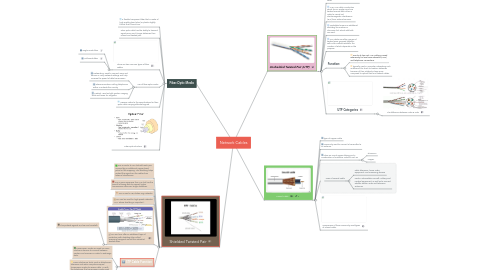
1. Fiber-Optic Media
1.1. a flexible transparent fiber that is made of high quality glass (silica) or plastic slightly thicker than human hair.
1.2. Fiber optic cable has the ability to transmit signals over much longer distances than coaxial and twisted pair.
1.3. There are two common types of fiber cables:
1.3.1. Single-mode fiber
1.3.2. Multimode fiber
1.4. use of fiber-optic media
1.4.1. Networking--used to connect users and servers in many network settings and help increase the speed of data transmission
1.4.2. Telecomunication-Calling telephones within or outside the country
1.4.3. Medical- used as light guides, imaging tools and lasers for surgeries
1.5. 10BaseF refers to the specifications for fiber optic cable carrying Ethernet signals.
1.6. Fiber-optic structure
2. Shielded Twisted Pair
2.1. STP is similar to UTP but with each pair covered by an additional copper braid jacket or foil wrapping. This shielding helps protect the signals on the cables from external interference.
2.2. STP is more expensive than UTP but has the benefit of being able to support higher transmission rates over longer distances.
2.3. STP is used in IBM token ring networks.
2.4. STP can be used for high-speed networks, ATM, where shielding is important .
2.5. STP and FTP offer an additional layer of protection with shielding (also called screening) wrapped around the individual twisted wires.
2.5.1. This protects against EMI/FRI and crosstalk.
2.6. STP Cable Function
2.6.1. Transmission media are used on some electronic devices to connect between senders and receivers in order to exchange data.
2.6.2. Some electronics tools, such as telephones, television and radio computers require transmission media to receive data. As with the telephone, the transmission media used to connect two phones is a cable. Each electronic device has different transmission media in its data transmission.
3. Unshielded Twisted Pair (UTP)
3.1. widely used in the computer and telecommunications industry as Ethernet cables and telephone wires
3.2. In an UTP cable, conductors which form a single circuit are twisted around each other in order to cancel out electromagnetic interference (EMI) from external sources.
3.3. Unshielded means no additional shielding like meshes or aluminum foil, which add bulk, are used.
3.4. UTP cables are often groups of twisted pairs grouped together with color coded insulators, the number of which depends on the purpose.
3.5. Function:
3.5.1. Due to its low cost, UTP cabling is used extensively for local-area networks (LANs) and telephone connections.
3.5.2. typically used in computer networking such as Ethernet for short-to-medium distances because of their relatively cheap price compared to optical fiber and coaxial cables.
3.6. UTP Categories
3.6.1. The difference between Cat5 & Cat6
4. Coaxial Cable
4.1. type of copper cable
4.2. commonly used to connect a transmitter to an antenna.
4.3. relies on round copper tubing and a combination of metals as a shield, such as
4.3.1. aluminum
4.3.2. copper
4.4. Uses of Coaxial Cable
4.4.1. cable television, home video equipment, and measuring devices
4.4.2. used in automobiles, aircraft, military and medical equipment, as well as to connect satellite dishes, radio and television antennae

